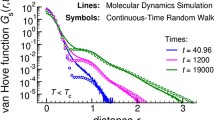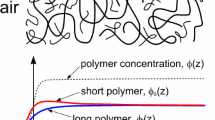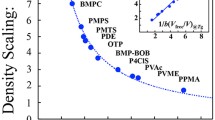Abstract
Following Flory’s ideality hypothesis, the chemical potential of a test chain of length n immersed into a dense solution of chemically identical polymers of length distribution P(N) is extensive in n . We argue that an additional contribution \( \delta\) \( \mu_{{{\rm c}}}^{}\)(n) ∼ +1/\( \rho\) \( \sqrt{{n}}\) arises (\( \rho\) being the monomer density) for all P(N) if n ≪ 〈N〉 which can be traced back to the overall incompressibility of the solution leading to a long-range repulsion between monomers. Focusing on Flory-distributed melts, we obtain \( \delta\) \( \mu_{{{\rm c}}}^{}\)(n) \( \approx\) (1 - 2n/〈N〉)/\( \rho\) \( \sqrt{{n}}\) for n ≪ 〈N〉2 , hence, \( \delta\) \( \mu_{{{\rm c}}}^{}\)(n) \( \approx\) -1/\( \rho\) \( \sqrt{{n}}\) if n is similar to the typical length of the bath 〈N〉 . Similar results are obtained for monodisperse solutions. Our perturbation calculations are checked numerically by analyzing the annealed length distribution P(N) of linear equilibrium polymers generated by Monte Carlo simulation of the bond fluctuation model. As predicted we find, e.g., the non-exponentiality parameter K p \( \equiv\) 1 - 〈N p〉/p!〈N〉p to decay as K p \( \approx\) 1/\( \sqrt{{\langle N \rangle }}\) for all moments p of the distribution.
Similar content being viewed by others
References
P.G. de Gennes, Scaling Concepts in Polymer Physics (Cornell University Press, Ithaca, New York, 1979)
M. Doi, S.F. Edwards, The Theory of Polymer Dynamics (Clarendon Press, Oxford, 1986)
L. Schäfer, Excluded Volume Effects in Polymer Solutions (Springer-Verlag, New York, 1999)
We suppose throughout this paper that $\pchain$ is a realistic polymer length distribution which is not too broad. All moments $\Npav^{1/p}$ exist and are of the same order. Obviously, all moments of monodisperse melts of length $N$ become $\Npav^{1/p} = N$
M. Cates, S. Candau, J. Phys.: Condens. Matter 2, 6869 (1990)
J.P. Wittmer, A. Milchev, M.E. Cates, J. Chem. Phys. 109, 834 (1998)
The chain length distribution is obtained by minimizing a Flory-Huggins free-energy functional equation* f[] = _N (() + N + E + (N)), equation* with respect to the density $\rhochain = \rho \pchain/\Nav$ of chains of length $N$. The first term on the right is the usual translational entropy. The second term entails a Lagrange multiplier which fixes the total monomer density $\rho = \sum_N N \rhochain$. All contributions to the chemical potential of the chain $\muchain$ which are linear in $N$ can be adsorbed within the Lagrange multiplier. The scission energy $E$ characterizes the enthalpic free-energy cost for breaking a chain bond. The most crucial last term encodes the remaining non-linear contribution $\dmuchain(N)$ to the chemical potential $\muchain$ which has to be paid for creating two new chain ends. A rigorously Flory-distributed length distribution implies thus $\dmuchain(N) = \tx{const}$
I. Yerukhimovich, V. Irzhak, V. Rostiashvili, Polym. Sci. USSR 18, 1682 (1976)
I. Yerukhimovich, Polym. Sci. USSR 19, 2743 (1977)
E. Nikomarov, S. Obukhov, Sov. Phys. JETP 53, 328 (1981)
J.P. Wittmer, H. Meyer, J. Baschnagel, A. Johner, S.P. Obukhov, L. Mattioni, M. Müller, A.N. Semenov, Phys. Rev. Lett. 93, 147801 (2004)
J.P. Wittmer, P. Beckrich, A. Johner, A.N. Semenov, S.P. Obukhov, H. Meyer, J. Baschnagel, Europhys. Lett. 77, 56003 (2007)
P. Beckrich, A. Johner, A.N. Semenov, S.P. Obukhov, H.C. Benoît, J.P. Wittmer, Macromolecules 40, 3805 (2007)
J.P. Wittmer, P. Beckrich, H. Meyer, A. Cavallo, A. Johner, J. Baschnagel, Phys. Rev. E 76, 011803 (2007)
H. Meyer, J.P. Wittmer, T. Kreer, P. Beckrich, A. Johner, J. Farago, J. Baschnagel, Eur. Phys. J. E 26, 25 (2008)
J.P. Wittmer, A. Cavallo, T. Kreer, J. Baschnagel, A. Johner, J. Chem. Phys. 131, 064901 (2009)
J.P. Wittmer, A. Johner, S.P. Obukhov, H. Meyer, A. Cavallo, J. Baschnagel, Macromolecules 43, 1621 (2010)
A.N. Semenov, A. Johner, Eur. Phys. J. E 12, 469 (2003)
A. Cavallo, M. Müller, J.P. Wittmer, A. Johner, J. Phys.: Condens. Matter 17, S1697 (2005)
J.P. Wittmer, P. Beckrich, F. Crevel, C.C. Huang, A. Cavallo, T. Kreer, H. Meyer, Comput. Phys. Commun. 177, 146 (2007)
I. Carmesin, K. Kremer, Macromolecules 21, 2819 (1988)
A.N. Semenov, S.P. Obukhov, J. Phys.: Condens. Matter 17, 1747 (2005)
D. Wu, G. Fredrickson, J.P. Carton, A. Ajdari, L. Leibler, J. Polym. Sci. Part B: Polym. Phys. 33, 2373 (1995)
Strictly speaking, we refer here and below to the compressibility of asymptotically long chains or, equivalently, to the excess contribution $\gex$ of the compressibility given by $1/\gex(\rho) = 1/g(\rho,N) - 1/N$ GHF95,WCK09. The difference is irrelevant for the large chains described in this paper.
The chemical potential of a chain does depend on the length distribution of the melt, eq. (eq_reg3dRSb). For infinite macroscopically homogeneous systems it is independent, however, of whether this distribution is annealed or quenched, i.e. if it is allowed to fluctuate or not. This follows from the well-known behavior of fluctuations of extensive parameters in macroscopic systems: the relative fluctuations vanish as $1/\sqrt{V}$ as the total volume $V\rightarrow \infty$. The latter limit is taken first in our calculations, i.e. we consider an infinite number of (annealed or quenched) chains. The large-$N$ limit is then taken afterwards to increase the range of the scale-free effective interaction potential, eq. (eq_veff_q2)
M. Abramowitz, I.A. Stegun, Handbook of Mathematical Functions (Dover, New York, 1964)
D. Frenkel, B. Smit, Understanding Molecular Simulation -- From Algorithms to Applications, 2nd edition (Academic Press, San Diego, 2002)
M. Müller, W. Paul, J. Chem. Phys. 100, 719 (1994)
H. Deutsch, K. Binder, J. Chem. Phys. 94, 2294 (1991)
C.C. Huang, H. Xu, F. Crevel, J. Wittmer, J.P. Ryckaert, Reaction kinetics of coarse-grained equilibrium polymers: a Brownian Study, in Computer Simulations in Condensed Matter: from Materials to Chemical Biology, Springer Lect. Notes Phys. 704, 379 (2006)
D. Shirvanyants, S. Panyukov, Q. Liao, M. Rubinstein, Macromolecules 1, 1475 (2008)
K. Shimomura, H. Nakanishi, N. Mitarai, Phys. Rev. E 80, 051804 (2009)
Author information
Authors and Affiliations
Corresponding author
Rights and permissions
About this article
Cite this article
Wittmer, J.P., Johner, A., Cavallo, A. et al. Non-extensivity of the chemical potential of polymer melts. Eur. Phys. J. E 31, 229–237 (2010). https://doi.org/10.1140/epje/i2010-10571-9
Received:
Revised:
Accepted:
Published:
Issue Date:
DOI: https://doi.org/10.1140/epje/i2010-10571-9




